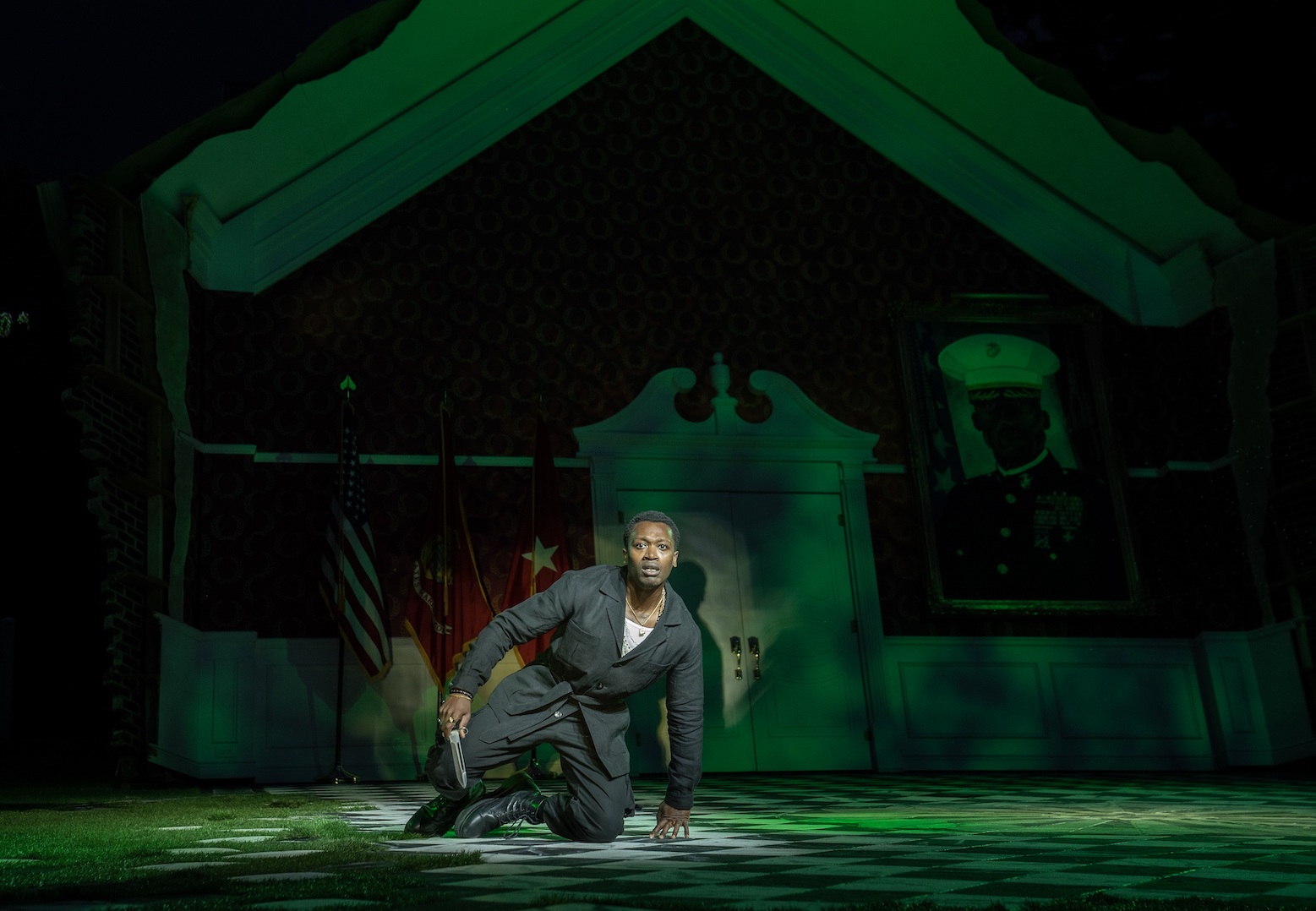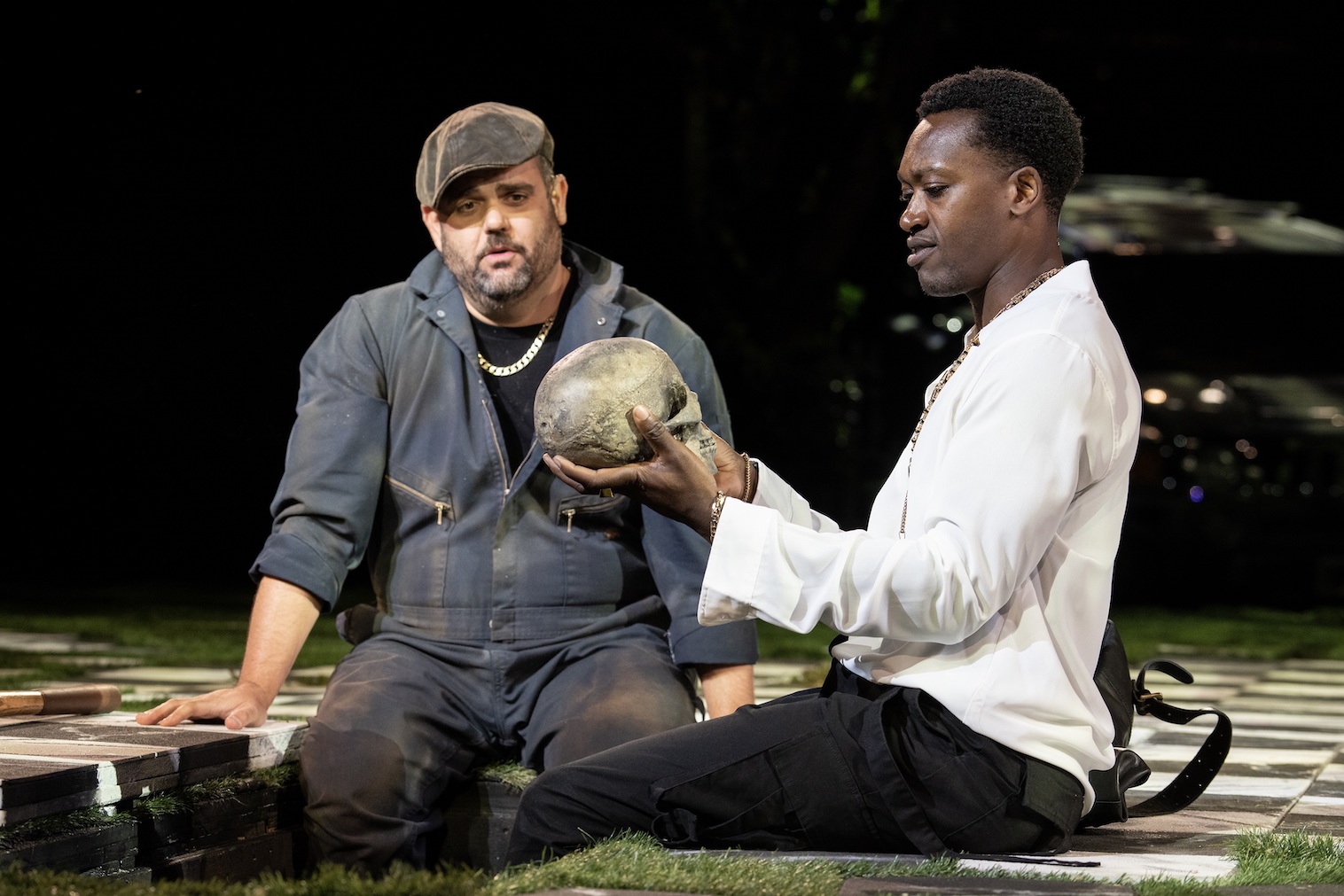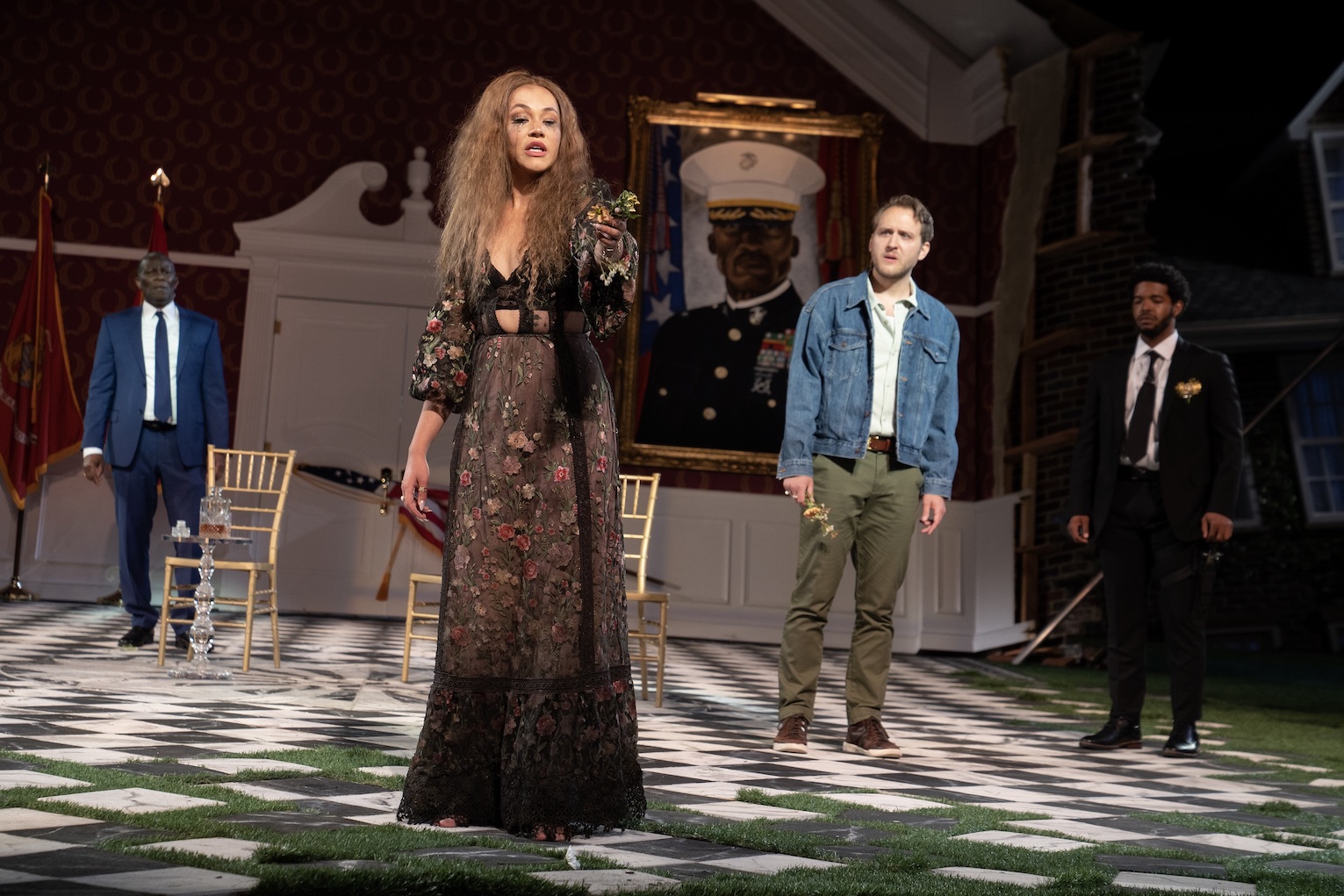** 1/2 (2.5 stars out of 5)
This summer’s Shakespeare in the Park/Public Theater production of Hamlet is, essentially, a swan song for the beloved Delacorte Theater in Central Park as we know it. At the end of the summer, the outdoor amphitheater will be so massively renovated that it is not scheduled to re-open until summer of 2025. So, it would be reasonable to expect this production of Hamlet to be a jewel, a salute to all the historic and groundbreaking performances that have taken place on that stage in the past 50+ years. Alas, despite a few admirable components, that has not turned out to be the case.
Multiple Tony Award-winning Director Kenny Leon, celebrated for so many terrific interpretations of classic plays as well as a brilliant, Tony winning revival of Top Dog/Underdog this past season, has taken far too many liberties with what many consider Shakespeare’s best play. The trouble starts right from the opening scene. While it’s perfectly understandable for directors (and dramaturges—though, shockingly, none appears to have been employed for this production) to make cuts in this potentially four-hour play for time and clarity, Leon has gone edit-crazy. To start with, he chose to delete the mood and story-setting scene that opens the play—soldiers on guard on the castle ramparts who have witnessed the appearance of the ghost of Denmark’s recently deceased monarch, King Hamlet.

The dialog in these scenes importantly lays the groundwork for the story that is to follow. But Leon has chosen, instead, to begin by writing in a funeral of the King, complete with a gospel quartet, who sing not one, not two, but four funereal dirges, including a musicalized version of Ecclesiastes 3:1, “To every thing there is a season, and a time to every purpose under heaven . . .” (popularized in song by the rock group, The Byrds, in 1965, as “Turn, Turn, Turn”). The coda is, puzzlingly, “Day-O (The Banana Boat Song),” a Jamaican folk song popularized by the late Harry Belafonte, but now best known for its inclusion in the film and musical versions of the whimsical Beetlejuice. Huh? Not only do the songs feel shoe-horned into the play, they provide no useful or logical context.
Unfortunately this inexplicable opening was not the play’s only shortcoming. Casting, always pivotal in a good Shakespeare play, turned out to be one of the biggest problems (despite noteworthy performances here and there, particularly the always amazing John Douglas Thompson as Claudius) that tainted the production. Though he has proven himself a wonderful actor in numerous Broadway and Shakespeare productions, Ato Blankson-Wood (Slave Play, As You Like It) is simply not the right actor to play Hamlet. He lacks both the pathos and the passion to dig deeply into this most complicated of characters in the history of theater. We expect a Hamlet who keeps us on our toes, with whom we alternate between loathing (or bemoaning) and sympathizing. He cannot be, as Blankson-Wood turned out, to be one-dimensional and easy to comprehend. Wood’s “To be or not to be . . . “ soliloquy contained no more emotional depth than if it were recited by a good acting student who had never read the rest of the play. This speech, alone, should make us understand and feel Hamlet’s emotional pain right down to the tips of our toes.

Even adequately executed scenes, like the gravediggers’ (“Alas, poor Yorick . . .”), lack not only the usual pepper, but since much of the play’s emotional center has been drained through massive cuts in dialog, the dramatic contrast that elicits the dark humor laughs of surprise and relief has disappeared.
Despite still more directorial misfires—including the Players theater troupe being replaced by an early 90s hip hop outfit, replete with dayglo outfits and an annoyingly auto-tuned singer (which seems unnecessary, considering that Broadway performers are known for their natural singing abilities)—there are some pleasant surprises. Solea Pfeiffer, whom we last saw originating the charming Penny Lane in the Broadway version of Almost Famous, is a convincing and sympathetic Ophelia, whose gorgeous singing makes the young woman’s descent into madness (which nonetheless lacks reason because of script cuts) more painful to witness, and her songs (which have always grated) far more palatable.

In making this Hamlet, Leon seems to have wanted to capture the magic of his brilliant 2019 production of Much Ado About Nothing. He even went so far as to bring back nearly the same set: a modern, brick, southern estate (by Beowulf Boritt, who seems to be championing recycling of late), complete with a “Stacey Abrams 2020” campaign sign, and a Range Rover SUV parked in the driveway (this version is probably a hearse, and cheekily sports a license plate that reads, “ELSNOR.”) But, now the manse looks as if it’s been struck by a tornado, teetering backward, on the verge of collapse, the banner half embedded in the ground—a rather on-the-nose allegory of the chaos that has befallen the US in recent years. And then there’s the representation of the ghost of Hamlet’s father, once again on a distorted video screen. This trope has been used over and over in modern productions (none so well as Robert Icke’s Hamlet last summer at the Park Avenue Armory), and it’s rarely captivating, and certainly isn’t here.
Too many elements of the production come off as puzzling and fail to fill in for the elided scenes. I was left with so many questions that I doubt shall ever be answered. Why, for example, was the courtier Osric (Tyrone Mitchell Henderson) portrayed as flamboyantly lisp-y and limp-wristed? Why, in this era that has so much focus on diversity and Inclusion, would such a clichéd stereotype of gay men be injected into the play for ugly laughs? Why did Laertes sing (a song not in the original play) at Ophelia’s grave, rather say his brief, but impactful, “O, treble woe” speech? Why were there such striking similarities between the costuming (especially the Marines uniform on the portrait of the King) and set of this play and the brilliant Fat Ham (which doesn’t pretend to be Hamlet, but is actually a better version than this)?

In Hamlet’s final scene, there is, as written, a touching scene between Hamlet and Laertes, in which Hamlet acknowledges his madness and begs Laertes’ forgiveness for the damage it has done: “ . . . I have shot my arrow o’er the house/And hurt my brother,” Hamlet proclaims. But those important and powerful lines, and ten or so before them, have been cut. They would have appeared confusing, because this abbreviated and simplified version has been reduced to a simple story of vengeance and revenge. The audience, and even the actors, thereby, have been deprived of the complexities and nuances of this great play.
This isn’t the first Shakespeare in the Park production, of late, to suffer from excessive editing. One almost wonders if the creative teams at The Public have been simplifying their productions out of concern that audiences aren’t capable of (or interested in) processing complex stories with challenging dialog. Hopefully, that isn’t the case. The People have always been up for the challenge and don’t need help to appreciate Shakespeare, which is fundamental to founder Joseph Papp’s vision.
Hamlet. Through August 6 at the Delacorte Theater (in Central Park at West 81st Street and Central Park West). Two hours 30 minutes with one intermission. www.publictheater.org












